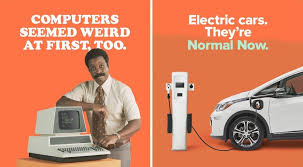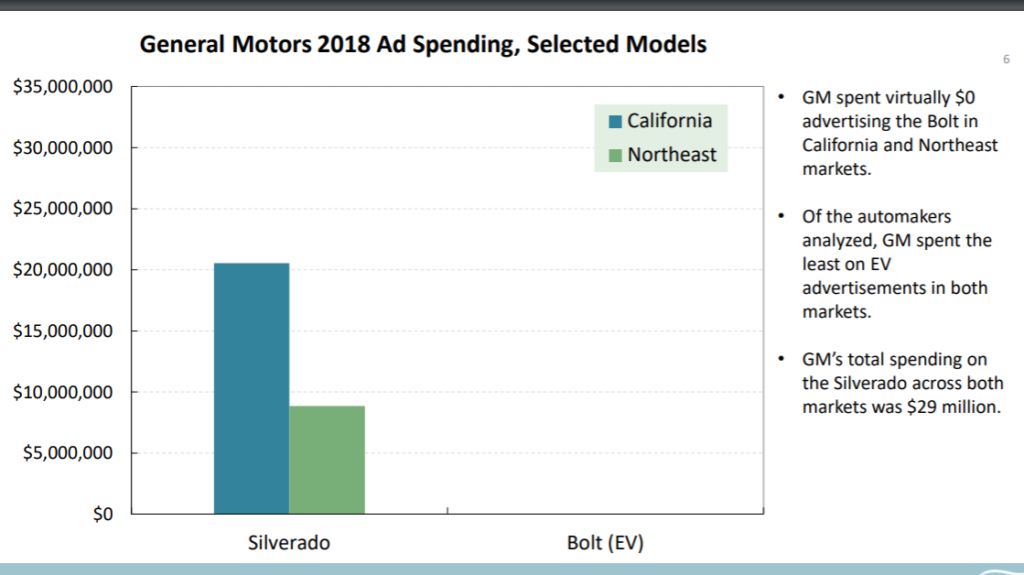
“Climate change begins in your garage….”
“The new freedom is freedom from the pump …”
“300 miles and miles to go before I sleep”
These sing-song lines are not as memorable as, “1-800 Kars for Kids” but if we wish to sell more electric cars to the public, we need to immortalize some catchy phrases. Electric cars are not under-powered, they are under-advertised.
Here are a few numbers about the marketing budgets for EVs. They will not overwhelm.
The NewYork Times/Kantar Research reports that electric vehicles received just 0.3% of national and local advertising budget last year. They did not include dealer ads.
Data compiled for NESCAUM, a consortium of eight New England states, shows that in 2017 GM spent $6.2 million in advertising when it introduced its 260 mile range electric car, the Bolt. The next year, General Motors spent $29 million to promote the Silverado in California and the Northeast, but zero dollars to continue promotion of the EV Bolt. (see image)

Nissan spent more on marketing (in the Northeast and California) than other automakers, a total of about $9 million for the Electric Leaf but about 18 times more, around $51 million promoting its gas-car, the Rogue. These numbers should be interpreted selectively, since the data is regional and excludes ads that ran nationally.
These budgets should be compared and contrasted with total marketing for the auto industry. It exceeds $18 billion in the US, and about $17.5 more in 13 other key markets.
In Europe in 2018, 3% of the industry’s advertising went to EVs, despite the fact that 30% of the public expressed willingness to buy one. In Norway, where 40% of new car sales are electric, car companies spend just 10% of their advertising budget on non-fossil vehicles. Why? The report from a consortium of European universities (ECIU) notes that it is more profitable to push consumers towards combustion vehicles.
Tesla is Ad-Free
Meanwhile, Tesla spends no money on advertising at all. Elon Musk has said since the beginning that “if you produce a truly revolutionary product, the marketing will take care of itself.” However, this approach overlooks the publicity role played by Musk himself. His name, which is the same as the eponymous car, is continually in front of people with promotion of the TSLA stock, plus his inventive stories for new technology like the SpaceX Crew Dragon. This past week Musk dissolved his public relations department.
So, is Elon Musk right, the need for advertising and marketing for electric cars is superfluous? Probably not. As an entrepreneur he must keep his sales pitches and the Fremont’s factory production in balance, as assembly lines are not elastic.
Marketing and advertising (M & A) are the missing component for GM, Jaguar, Honda, and other manufacturers. First and foremost, M & A are needed to bring awareness to the product. According to EV pioneer, industry guru and researcher, Ken Kurani, there has been little change in Northern Californians’ awareness and knowledge about EVs over the past five years. U.C. Davis surveys find that 55% of respondents cannot recall the name of an EV sold in the U.S., and another 12% get the name wrong.
Marketing and Advertising (M & A) Can Do More
Second, we need M& A to correct misconceptions about performance and range. During the last rollout of EVs, in the mid 1990s, the cars traveled only 80 to 100 miles on a full battery. Now the most basic Chevy Bolt and Tesla models get 260 miles of range.
We should distinguish advertising for the electric vehicle industry at large, versus advertising for specific vehicles. Educational/safety announcements are needed too so that car shoppers learn that plugging in is easy, that the safety records are good and the cost of operations is low.
There are certain market segments who might be reached first: say young people who are committed to climate change or longer-distance commuters who fill up gas tank at least twice a week. These groups might, if traditional marketing holds, serve as opinion leaders for the general public. But, that may be too narrow.
Older people are likely to enjoy EVs because the cars are basically maintenance free. ‘Road and Track’ type enthusiasts may find the torque to be exceptional, and tech people are likely to marvel at the energy storage. It’s hard to judge which market segment should lead the innovation.
But first, all these groups need to see messages that depict electric cars to be affordable. They also need to decouple personal freedom and joie- de- vive from the gasoline vehicle. Perhaps the public needs to see the same ads, over and over again, of a shiny new electric car with extended range traveling the length of California 1, an electric car towing a small boat to a private dock, or a plucky EV overtaking other vehicles as it climbs a steep mountain pass. Few automobile ads show traffic and urban driving- the EV has an edge here too because it actually does something good in stop-and go-traffic; it recharges.
SuperBowl 2020, Not
There was hope that the iconic commercials during 2020 SuperBowl would change minds and hearts. There were three ads for EVs: an electric GMC Hummer Truck, a Porsche Taycan, and the Audi e-tron. Two of these futuristic cars were German made, and the GMC vehicle was not in production. The ads were sizzle and sex for specialty vehicles, priced at tens of thousands beyond the reach of everyday drivers.
These three SuperBowl ads may have had a boomerang effect: “electric vehicles are exotic, very rich people have them as toys, and they are not market- ready.” Meanwhile, ad “pundits” found that a less flamboyant SuperBowl commercial did succeed in in introducing the public to a new technology; a Hyundai Sonata that self-parked, (or “pahked” in a distinctive Boston drawl).
EV bike to cars
The Superbowl ads made a splash, albeit a short lived one. Since the country soon thereafter plunged into the Covid lockdown it is hard to judge. However, sales of a different electric propulsion system, the electric bicycle flourished, and this is a promising start.
Automotive companies do not have a mandate to advertise the electric car, and at this point there are few incentives for them to do so. Tesla, the notable exception, succeeds because it runs on Musk’s publicity machine and importantly, the company does not compete with itself, as there are no gas-powered Teslas to be sold.
But, imagine if gasoline vehicles were downplayed in future advertising, and the full array of electric vehicles were marketed instead through the gargantuan $8 billion dollar car ad budget. There might be a chicken in every pot (rubber one?) and an EV in every garage.